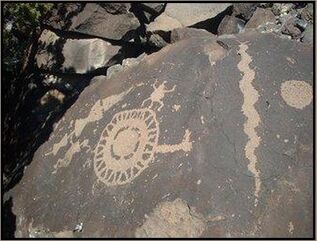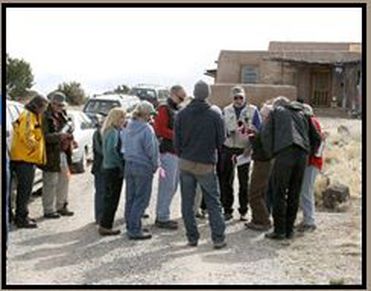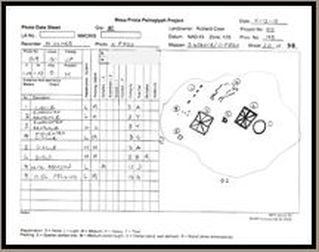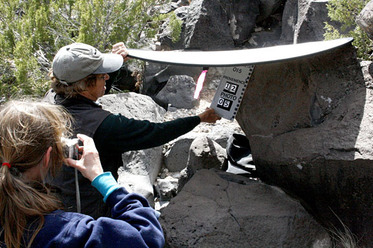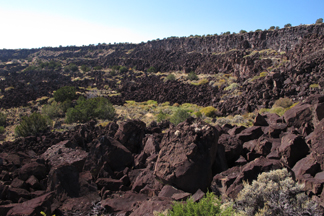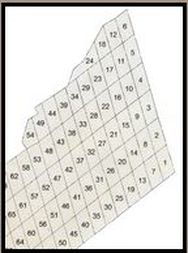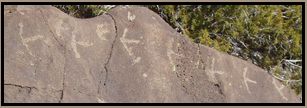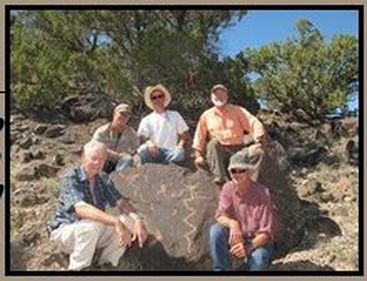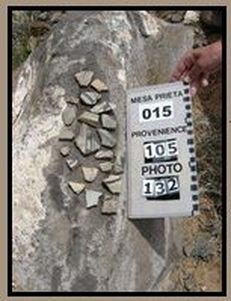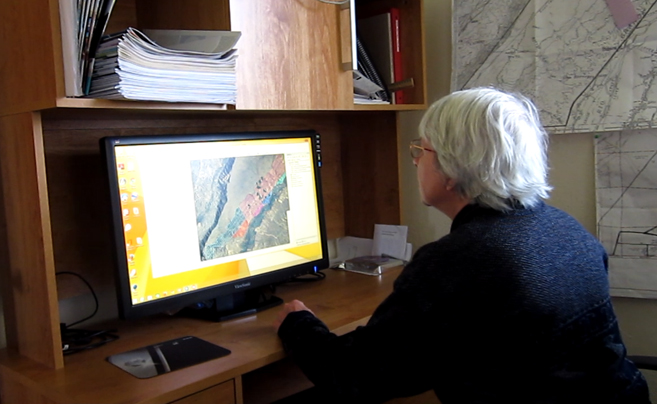Preservation
Protection
Protection and preservation of Mesa Prieta is the founding theme of the entire project. Preservation will only happen through education. Preservation ethic is promoted in all aspects of public interaction: docent-led tours, public presentations, training of volunteers, the Summer Youth Intern Program, the school curriculum “Discovering Mesa Prieta”, and recording and survey work.
Particularly important to the project and to the preservation of the petroglyphs is a strong relationship with local Pueblos. Many of the images were undoubtedly made by their ancestors. Our educational initiatives expose youth and adults from the Pueblos of Ohkay Owingeh, Santa Clara, San Ildefonso, Taos and others to the existence of the petroglyphs and to the ethics of heritage preservation and stewardship.
In 2014, The Wells Petroglyph Preserve was listed among the nation's eleven most threatened and at-risk art-in-the-landscapes by the Cultural Landscape Foundation (TCLF). Selected from over 100 submissions, the sites recognized in 2014 are detailed through in-depth narratives and newly commissioned photography by the Landslide® 2014: Art and the Landscape's thematic compendium. MORE
Sustaining Cultures
The Mesa Prieta Petroglyph Project approaches the work conducted with respect for the cultures that created the petroglyphs and artifacts. Mesa Prieta volunteers are taught to respect the images and cultural features found on the mesa. They are asked to demonstrate objectivity when discussing and categorizing rock images, rather than to attempt to interpret what they mean. While the temptation may be to describe the images in context with our present |
This beautifully executed, complex Ancestral Puebloan panel exhibits clearly identifiable
|
culture, this is not appropriate. We were not present when the images were made and we have no way of knowing what they mean. To assume that we do would be disrespectful.
Project leaders work closely with the local Pueblos and are sensitive to their connection with the pre-historic images. We seek cultural participation from Pueblo members and affiliates.
Recording
As stated in the mission statement, a primary goal of the Mesa Prieta Petroglyph Project is to record what may be well over 100,000 rock images on the mesa. This effort has been underway since 2002 and is expected to take decades to complete.
Recording Protocols
|
All petroglyph recording trainees are instructed
|
Petroglyph Recording Training is now held once a year in the spring based on the needs of the project. Trainee volunteers are instructed in the use of Global Positioning System (GPS) units and digital cameras. They learn how to take metric measurements and compass readings and they become proficient in the drawing skills needed to document images. In addition, they are instructed in the protocols of placing images into the categorical system developed by the Crottys and Brodys. This system, called the Rio Grande Style Petroglyph Categorization System, was developed to categorize most of the rock images found in New Mexico, especially in the region of the Rio Grande, running from the Colorado border to Texas and Mexico. Volunteers are also introduced to the dynamics of working in teams, which enhances accuracy, as well as encourages discussion of how to categorize the elements.
Each petroglyph panel is carefully documented on a Photo Data Sheet (PDS). Recorders are taught how to assess each petroglyph and enter the appropriate documentation. All recording guidelines adhere to the standards set by the Archaeological Society of New Mexico Rock Art Council that assures consistency for all recording groups working in New Mexico. |
The training consists of a full day of classroom instruction, followed by two field training days, before a volunteer is assigned to work with a team in the field. Mentors then work with each trainee at least two additional days in their assigned teams, for a total of five days of training. Neat, accurate and complete recording work is emphasized. Project mentors stress that it is unlikely the archaeological features being recorded will ever be recorded again and that the data collected becomes the permanent archival record. Currently about thirty volunteers work as petroglyph recorders and surveyors on Mesa Prieta. Recorders must be able to hike up to a mile each way in very rugged, steep terrain to access recording areas. |
Recording Challenges
Petroglyphs exist all across the mesa in varying densities. Clusters exist around flat areas higher on the sides of the mesa that may have been used for field houses, ceremonial or agricultural purposes. Other very dense areas are found in difficult to reach, remote areas on the mesa. Conducting a proper archaeological survey presents challenges. |
A recording team is shown working in a
|
cobbles on coarse gravel and fields of basalt boulders. Prickly pear cactus, an additional hazard, abounds in many areas. All proveniences have difficult areas which must be traversed. Road access to Mesa Prieta is also difficult. Only one road penetrates the mesa, that road crosses private land. A utility road extends the full length of the mesa top; however, few access points exist and much of the road requires four-wheel drive, high clearance vehicles. Many areas to be recorded are within a fifteen to forty-five minute walk from the base or top of the mesa, but much of the recording will require several hours of difficult hiking to reach the areas to be documented. A number of prehistoric trails have been identified; these trails often are marked with turkey track petroglyphs.
The 6800 acres of private land on which recording volunteers are currently working is so vast and rugged that survey teams are sent into areas to assess the presence, quality and density of petroglyphs before recording teams are assigned. The survey teams also determine the difficulty of access and terrain in a given area. This provides the opportunity to prioritize proveniences for assignment to recording teams. Proveniences are a determined area of land identified for a give purpose. On Mesa Prieta, a provenience is about 20 acres. Obtaining accurate maps establishing borders and boundaries of both public and private land has been challenging. Thanks to GPS and Geographic Information System (GIS), areas that have been surveyed and recorded can be designated on area maps. GIS software loaded on GPS units has provided locational guidance for the teams as they work on the mesa. The vast extent of the mesa that has not been surveyed or recorded far exceeds those areas already completed.
This GIS map of a large piece of private property on Mesa Prieta shows some of almost two hundred proveniences that recording teams are assigned to. |
This image has a row of turkey tracks on one boulder, other
|
The process of recording is described, including the entry of the data into a GIS data base and ultimately into the Archaeological Records Management Section
(ARMS) for archival storage and research. ARMS is the New Mexico agency that houses, maintains and protects all records of archaeological investigation in the State of New Mexico. MORE Each land owner receives copies of all documentation completed on his land with all the photographs taken placed on a CD. In addition, a Land Owner Report is written that includes information on archaeological findings on the mesa, MPPP activities and a section that features the most unique images recorded on that person's property printed in 8X10 color photos with the accompanying PDS forms.
In the past several years, multiple land owner on and near Mesa Prieta have requested or responded to requests that the petroglyhphs on their land be recorded. Teams are assigned, the recording is completed at no cost to the owner.
Data Management
As volunteers complete field recording, all data and photos undergo two quality checks for accuracy and completeness. Photos are cropped, filtered and sharpened to provide excellent visual information. Camera-designated file names are replaced with new names which identify the Laboratory of Anthropology LA and NMCRIS numbers, recording group (MPPP is Archaeological Society of New Mexico - Rock Art Council group 07) the land owner property (project), the provenience and the photo number unique to each locus. Suffixes are added to indicate a primary photo, a close-up or a context view. For example, 3942_134843_07_001_023_110PHO.png would be the file name of MPPP’s principal photo 110 in provenience 23 of the Wells Petroglyph Preserve. This complex nomenclature ensures that each photo is unique and can be retrieved from the database without confusion, even if all the petroglyph recording data collected in New Mexico were combined into one huge database as, indeed, they will be in the future.
All paperwork, including Photo Data Sheets, Mapper’s Notes, sketches and in-house management forms such as Field and Design Element tallies are scanned, and the resulting images given file names which match those of the photos. Smaller versions of all these images are created and given the suffix “TH”, for thumbnail. These are the versions which will be referenced by the petroglyph database.
Artifacts discovered during recording
|
Since volunteers are working in areas of private land that may never be visited again, the project also records whatever Cultural Landscape features they discover, such as structures, artifacts, water management elements and other significant historic and prehistoric findings. Collection of these data in a separate Cultural Landscape database assists in understanding the usage of the mesa by the various cultures that have occupied the area over thousands of years. In that trails, recent and ancient, help to tell this story, they are also recorded and those data are kept in a separate trails database.
|
proof files. The thousands of photos taken are stored in original and edited formats and protected by multiple backups on DVDs and external hard drives. Starting in 2015, all digital data will be stored on three national, geographically separated professionally staffed servers; MPPP is the first non-profit archaeological group in New Mexico to have this level of protection for its data.
The data are entered into a File Maker Pro® data base that mimics the petroglyph recording sheet used by the Mesa Prieta Project and other recording groups in the state.
|
Data entry contractor Janet MacKenzie works
|

